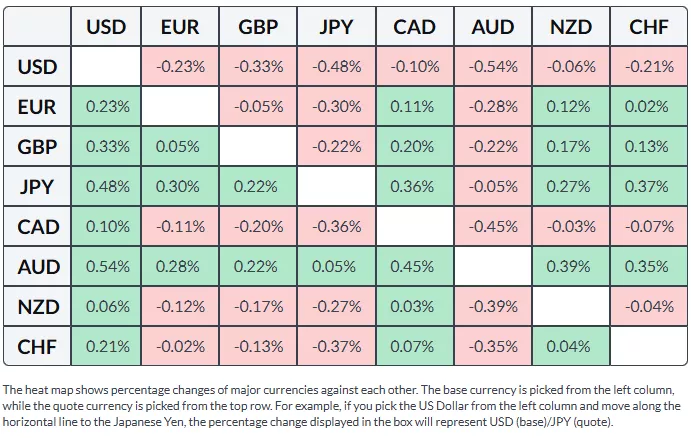Australian Dollar Gains As US Dollar Weakens On Fed Rate Cut Outlook
Image Source: Unsplash
The Australian Dollar (AUD) advances against the US Dollar (USD) on Wednesday, recovering its recent losses registered in the previous session. The AUD/USD pair appreciates as the AUD receives support from the cautious remarks from the Reserve Bank of Australia (RBA) Assistant Governor Sarah Hunter, who said that recent data has been a little stronger than expected, adding that inflation is likely to be stronger than forecast in the third quarter (Q3).
RBA Assistant Governor Sarah Hunter also said that labor market and economic conditions might be tighter than assumed. Hunter highlighted that uncertainty about the global outlook remains elevated and stated that the board will adjust policy as appropriate as new information comes to hand. Expected consumer momentum to soften a little in Q3, she added.
The AUD/USD pair moves little after the release of China’s Consumer Price Index (CPI), which declined 0.3% year-over-year (YoY) in September. The market consensus was for a 0.1% decline in the reported period, following a fall of 0.4% in August. Meanwhile, the monthly inflation rose to 0.1%, weaker than the expected 0.2%. China’s Producer Price Index (PPI) fell 2.3% YoY, following a 2.9% fall prior, as expected.
US President Donald Trump criticized China on Wednesday for its recent protectionist trade policies, threatening additional targeted trade restrictions if China goes ahead with imposing fresh rare earth mineral export controls and additional port fees for foreign container ships in Chinese ports. An hour earlier, Trump appeared to be hopeful on a trade reproach between the United States (US) and China.
The US and China decided to charge additional port fees on ocean shipping companies that transport everything from holiday toys to crude Oil. The US is scheduled to start collecting fees on Tuesday. China also started to collect the special taxes on US-owned, operated, built, or flagged vessels, but stated that Chinese-built ships would be exempted from the levies. It is important to note that any change in the Chinese economy could impact the AUD as China and Australia are close trading partners.
US Dollar extends its losses following dovish remarks from Fed Powell
- The US Dollar Index (DXY), which measures the value of the US Dollar against six major currencies, is extending its losses for the second successive session and trading around 98.90 at the time of writing.
- The Greenback faced challenges after US Federal Reserve (Fed) Chair Jerome Powell stated that the central bank is on track to deliver another quarter-point interest-rate reduction later this month, even as a government shutdown significantly reduces its read on the economy. Powell highlighted the low pace of hiring and noted that it may weaken further.
- The CME FedWatch Tool indicates that markets are now pricing in nearly a 94% chance of a Fed rate cut in October and a 93% possibility of another reduction in December.
- Philadelphia Fed President Anna Paulson said on Monday that rising risks to the job market argue for more interest rate cuts by the US central bank, as trade tariffs now appear unlikely to push up inflation as much as expected.
- The Federal Open Market Committee (FOMC) Minutes from the September meeting suggested policymakers are leaning toward further rate cuts this year. The majority of policymakers supported the September rate cut and signaled further reduction later this year. However, some members favored a more cautious approach, citing concerns about inflation.
- China's Trade Balance arrived at CNY645.47 billion in September, narrowing from the previous figure of CNY732.7 billion. Exports rose 8.4% YoY in September vs. 4.8% in July. The country’s imports advanced 7.5% YoY in the same period vs. 1.7% recorded previously. In US Dollar (USD) terms, China’s Trade Surplus came at $90.45 billion, expanded less than expected $98.96 billion in September, and was down from the previous $102.33.
- The RBA Minutes of its September monetary policy meeting showed on Monday that board members agreed that policy was still a little restrictive but difficult to determine. The RBA Meeting Minutes also noted that economic risks persist, with consumption remaining weak amid softer job and wage growth. Monthly CPI data for housing and services suggest that Q3 inflation may exceed forecasts. The RBA board emphasized that future policy decisions will continue to be cautious and strongly driven by incoming data.
- RBA Governor Michele Bullock remarked last week that services inflation remains somewhat persistent. She acknowledged that second-quarter inflation was slightly above expectations but continues to move in the right direction.
- Australia’s Consumer Inflation Expectations rose to 4.8% in October, up from 4.7% previously, the highest level since June. Growing concerns that inflation may surpass forecasts in Q3 reinforce the cautious outlook surrounding the Reserve Bank of Australia. Traders largely expect the RBA to hold interest rates steady after keeping the Official Cash Rate unchanged at 3.6% in September.
- Reuters, citing a report from The Age on Sunday, said a leaked brief from Australia’s Prime Minister Anthony Albanese’s department revealed that government officials have begun discussions with miners about contributing to a A$1.2 billion ($776.28 million) “critical minerals strategic reserve.” Australia is considering setting minimum prices for critical minerals and providing funding for new rare earth projects under a proposed resources agreement with the United States.
Australian Dollar rises to near 0.6500 despite prevailing bearish bias
The AUD/USD pair is trading around 0.6500 on Wednesday. Technical analysis on the daily chart indicates a prevailing bearish bias as the pair is remaining within a descending channel pattern. Additionally, the 14-day Relative Strength Index (RSI) is still positioned below the 50 level, strengthening a bearish bias.
On the downside, the AUD/USD pair may target the lower boundary of the descending channel around 0.6450. A break below the channel would strengthen the bearish bias and prompt the pair to test the four-month low of 0.6414, recorded on August 21, followed by the five-month low of 0.6372.
The primary barrier lies at the nine-day Exponential Moving Average (EMA) of 0.6532, followed by the 50-day EMA at 0.6553. A break above these levels would improve the short- and medium-term price momentum and lead the AUD/USD pair to test the descending channel’s upper boundary around 0.6590. Further advances above the channel would cause the emergence of the bullish bias and support the pair to explore the region around the 12-month high of 0.6707, recorded on September 17.
AUD/USD: Daily Chart

US Dollar Price Today
The table below shows the percentage change of US Dollar (USD) against listed major currencies today. US Dollar was the strongest against the New Zealand Dollar.

More By This Author:
EUR/JPY Price Forecast: Falls To Near 175.50 After Breaking Below Nine-Day EMAAustralian Dollar Loses Gains Despite RBA's Cautious Outlook
EUR/JPY Price Forecast: Trades Around 177.50 After Pulling Back From Fresh Highs
Information on these pages contains forward-looking statements that involve risks and uncertainties. Markets and instruments profiled on this page are for informational purposes only and should not ...
more



